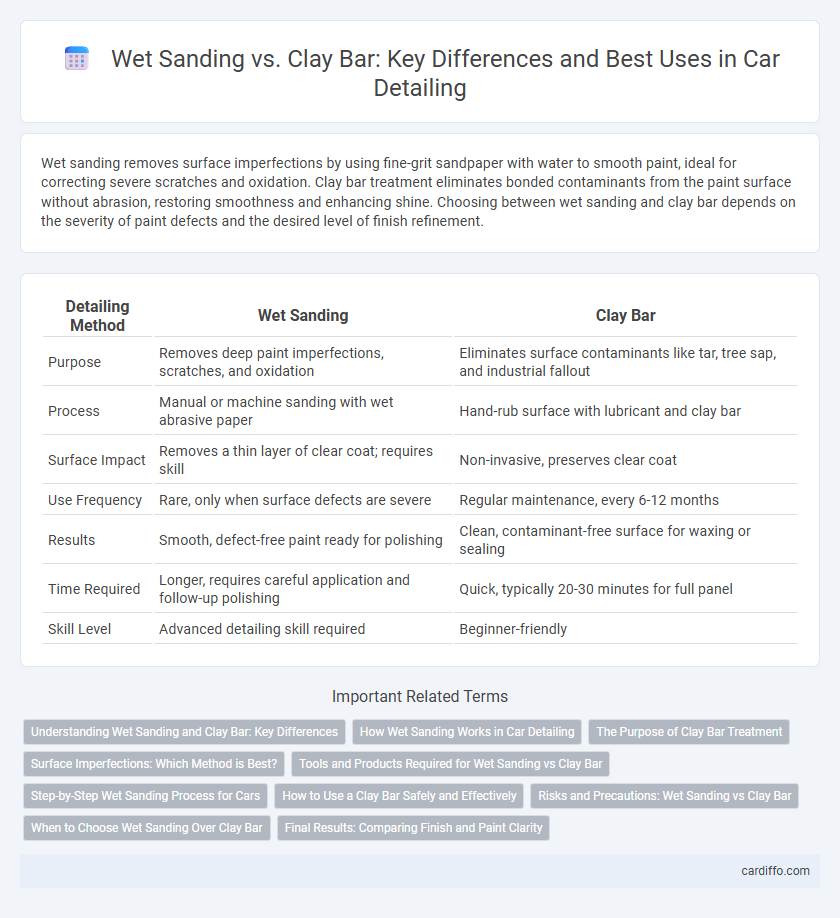Wet sanding removes surface imperfections by using fine-grit sandpaper with water to smooth paint, ideal for correcting severe scratches and oxidation. Clay bar treatment eliminates bonded contaminants from the paint surface without abrasion, restoring smoothness and enhancing shine. Choosing between wet sanding and clay bar depends on the severity of paint defects and the desired level of finish refinement.
Table of Comparison
| Detailing Method | Wet Sanding | Clay Bar |
|---|---|---|
| Purpose | Removes deep paint imperfections, scratches, and oxidation | Eliminates surface contaminants like tar, tree sap, and industrial fallout |
| Process | Manual or machine sanding with wet abrasive paper | Hand-rub surface with lubricant and clay bar |
| Surface Impact | Removes a thin layer of clear coat; requires skill | Non-invasive, preserves clear coat |
| Use Frequency | Rare, only when surface defects are severe | Regular maintenance, every 6-12 months |
| Results | Smooth, defect-free paint ready for polishing | Clean, contaminant-free surface for waxing or sealing |
| Time Required | Longer, requires careful application and follow-up polishing | Quick, typically 20-30 minutes for full panel |
| Skill Level | Advanced detailing skill required | Beginner-friendly |
Understanding Wet Sanding and Clay Bar: Key Differences
Wet sanding involves using fine-grit sandpaper with water to smooth out surface imperfections on automotive paint, targeting issues like orange peel or oxidation. A clay bar removes bonded contaminants such as tar, sap, and industrial fallout that regular washing cannot eliminate, restoring surface cleanliness and smoothness. Understanding these key differences helps detailers choose the appropriate technique for paint correction and surface prep.
How Wet Sanding Works in Car Detailing
Wet sanding in car detailing involves using fine-grit sandpaper soaked with water to gently smooth out the paint surface, removing imperfections such as scratches, oxidation, and orange peel texture. This technique requires controlled, even pressure to prevent damaging the clear coat while leveling the paint for a flawless finish. When executed properly, wet sanding enhances paint clarity and prepares the surface for polishing and sealing, restoring a showroom-quality appearance.
The Purpose of Clay Bar Treatment
Clay bar treatment removes embedded contaminants such as industrial fallout, brake dust, and overspray that washing alone cannot eliminate. It restores a smooth surface by extracting bonded particles, allowing for better paint clarity and preparation before polishing or waxing. This process enhances the vehicle's finish by preventing swirl marks and ensuring superior paint correction results.
Surface Imperfections: Which Method is Best?
Wet sanding effectively removes severe surface imperfections such as deep scratches and oxidation by using fine-grit sandpaper with water to smooth the clear coat. Clay bar treatment excels in eliminating embedded contaminants like tar, tree sap, and industrial fallout without damaging the paint surface. For optimal results, wet sanding is best for correcting heavier defects, while clay bar is ideal for maintaining a clean and smooth finish on mildly contaminated surfaces.
Tools and Products Required for Wet Sanding vs Clay Bar
Wet sanding requires the use of fine-grit abrasive sandpaper, a sanding block or dual-action sander, and plenty of water or a lubricant to prevent surface damage, with optional polishing compounds for finishing. Clay bar detailing involves a soft synthetic clay bar, a clay lubricant spray, and microfiber towels to safely remove contaminants from the paint surface. Both methods demand specific tools to achieve a smooth, clean finish, but wet sanding utilizes abrasive materials while clay bars rely on physical removal of embedded particles.
Step-by-Step Wet Sanding Process for Cars
Wet sanding involves using fine-grit sandpaper soaked in water to gently remove surface imperfections from a car's paint, enhancing smoothness and preparing the surface for polishing. The step-by-step process includes washing the vehicle thoroughly, wetting the sandpaper and surface, sanding in a consistent, circular motion with light pressure, frequently rinsing to prevent clogging, and checking progress to avoid over-sanding. After wet sanding, the surface requires polishing with a compound to restore gloss and protect the paint from future damage.
How to Use a Clay Bar Safely and Effectively
To use a clay bar safely and effectively, start by thoroughly washing and drying the vehicle to remove loose dirt. Lubricate the surface generously with a clay bar lubricant or a mixture of quick detailer and water, then gently glide the clay bar over the paint in straight motions, applying minimal pressure to avoid damaging the clear coat. Regularly inspect and fold the clay bar to expose a clean surface, discarding it if it becomes contaminated or overly dirty.
Risks and Precautions: Wet Sanding vs Clay Bar
Wet sanding carries risks such as clear coat damage and requires precise technique to avoid surface imperfections, demanding thorough masking and aggressive buffing post-process. Clay bar use is safer for routine contamination removal but can cause minor surface marring if used improperly or on excessively dry paint, necessitating proper lubrication and gentle pressure. Both methods require careful inspection and finishing, with wet sanding best reserved for professional use and clay bars suitable for regular maintenance.
When to Choose Wet Sanding Over Clay Bar
Wet sanding is ideal for correcting severe paint defects like deep scratches, orange peel, or heavy oxidation that a clay bar cannot address. Use wet sanding when the clear coat requires leveling and smoothing beyond surface contamination removal. Opt for wet sanding as a preparation step before polishing to achieve a flawless finish in automotive detailing.
Final Results: Comparing Finish and Paint Clarity
Wet sanding delivers a smoother surface by removing fine imperfections and paint orange peel, resulting in a high-gloss, even finish that enhances paint clarity. Clay bar treatment effectively removes surface contaminants and bonded particles, improving paint smoothness and shine but does not alter the paint texture or gloss level. For optimal final results, combining clay bar decontamination before wet sanding ensures maximum clarity and a flawless, mirror-like finish on automotive paint.
Wet Sanding vs Clay Bar Infographic

 cardiffo.com
cardiffo.com